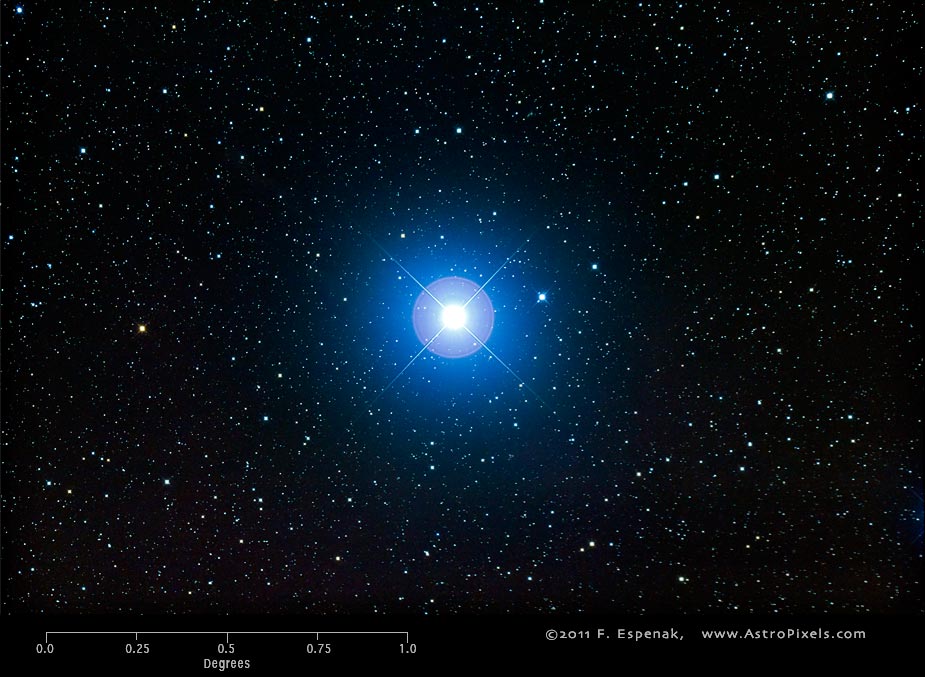Rigel
Rigel or Beta Orionis (Bet Ori) is the brightest naked eye star in the constellation Orion. With an apparent magnitude of 0.18v, Rigel is the 7th brightest star in the entire sky (see: 50 Brightest Stars ). Its absolute magnitude is -6.69 and its distance is 773 light years.The Equinox J2000 equatorial coordinates are RA = 05h 14m 32.3s, Dec = -08° 12' 06".
Rigel has a spectral type of B8Ia, a surface temperature of 11,000° Kelvin and a luminosity 66,000 times the Sun. It has a mass of 17 solar masses and a diameter 78 times the Sun.
The image above shows the uncropped view of Rigel (North is up) through the Takahashi E-180 Astrograph.
Rigel is the most luminous star in our local region of the Milky Way. The star is so bright that if viewed from a distance of 1 Astronomical Unit (Earth's distance from the Sun), it would shine as an extremely bright ball with an angular diameter of 35° with magnitude -38. The power flux at this distance is the same as the flux just a few millimeters from a welding arc; any object this close will be vaporized and blown away by the strong stellar wind.
Rigel is currently moving through a region of nebulosity. Consequently, the star lights up several dust clouds in its general vicinity, the most notable being the IC 2118 (the Witch Head Nebula). Rigel is also associated with the Orion Nebula (M42), which-while more or less along the same line of sight as the star-is almost twice as far away from Earth. Despite the difference in distance, projecting Rigel's path through space for its expected age brings it close to the nebula. As a result, Rigel is sometimes classified as an outlying member of the Orion OB1 Association, along with many of the other bright stars in that region of the sky; more specifically, it is a member of the Taurus-Orion R1 Association, with the OB1 Association reserved for stars closer to the nebula and more recently formed.
Rigel is a known visual binary and was first measured by F. G. W. Struve in 1831. Though Rigel B is not particularly faint at magnitude 6.7, its closeness to Rigel A-which is over 500 times brighter-makes it a challenging target for telescopes smaller than 150 mm (5.9 in). However a good 7 cm telescope will reveal Rigel B at 150x power and good seeing. At Rigel's estimated distance, Rigel B is separated from its primary by over 2200 AU; With such an enormous separation, there has been no sign of orbital movement, though they share the same proper motion.
Rigel B is itself a spectroscopic binary system, consisting of two main sequence stars that orbit their center of gravity every 9.8 days. The stars both belong to the spectral class B9V; Rigel B is the more massive of the pair, at 2.5 versus 1.9 solar masses.
Rigel is variable, in an irregular way common to supergiants, with a range from 0.03 to 0.3 of a magnitude over roughly 22 to 25 days.
The description above is based on the Rigel entry in Wikipedia.For more information about Rigel, see Stars (Jim Kaler).
Technical Details
- Object: Rigel
- Other Names: Beta Orionis, HR1713, HD34085, HIP24436
- Object Type: bright star
- Object Data: Apparent Magnitude = 0.18v, Absolute Magnitude = -6.69, distance = 773 light years
- Object Position (Equinox J2000): RA = 05h 14m 32.3s, Dec = -08° 12' 06", Constellation = Orion
- Date/Time: 2011 Apr 05 at 03:01:40 UTC
- Location: Bifrost Astronomical Observatory, Portal, AZ
- Mount: Astro-Physics 1200GTO
- Telescope: Takahashi Epsilon 180 Hyperbolic Astrograph
- Camera: Canon EOS 550D (Rebel T2i) (modified with a Baader UV/IR filter)
- Field of View: 1.70° x 2.56° at 1.7 arc-sec/pixel (web version: 10.0 arc-sec/pixel)
- Exposure: 2 x 300s, f/2.8, ISO 800
- File Name: Rigel-01w.jpg
- Processing (Adobe Camera Raw): Graduated Filter, Vignetting Correction, Noise Reduction, White Balance, Curves
- Processing (Photoshop CS5): Average Images, Curves, Noise Reduction
- Original Image Size: 3454 × 5179 pixels (17.9 MP); 11.5" x 17.3" @ 300 dpi
- Rights: Copyright 2011 by Fred Espenak. All Rights Reserved. See: Image Licensing.
